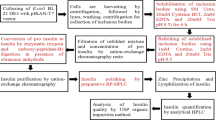Abstract
The recognition of the potential efficacy of plasmid DNA (pDNA) molecules as vectors in the treatment and prevention of emerging diseases has birthed the confidence to combat global pandemics. This is due to the close-to-zero safety concern associated with pDNA vectors compared to viral vectors in cell transfection and targeting. Considerable attention has been paid to the potential of pDNA vectors but comparatively less thought has been given to the practical challenges in producing large quantities to meet current rising demands. A pilot-scale fermentation scheme was developed by employing a stoichiometrically-designed growth medium whose exceptional plasmid yield performance was attested in a shake flask environment for pUC19 and pEGFP-N1 transformed into E. coliDH5α and E. ColiJM109, respectively. Batch fermentation of E. coliDH5α-PUC19 employing the stoichiometric medium displayed a maximum plasmid volumetric and specific yield of 62.6 mg/L and 17.1 mg/g (mg plasmid/g dry cell weight), respectively. Fed-batch fermentation of E. coliDH5α-pUC19 on a glycerol substrate demonstrated one of the highest ever reported pilot-scale plasmid specific yield of 48.98 mg/g and a volumetric yield of 0.53 g/L. The attainment of high plasmid specific yields constitutes a decrease in plasmid manufacturing cost and enhances the effectiveness of downstream processes by reducing the proportion of intracellular impurities. The effect of step-rise temperature induction was also considered to maximize CoIE1-origin plasmid replication.
Similar content being viewed by others
References
Institute of Medicine (2004) Forum on Microbial Threats, Board on Global Health. The Threat of Pandemic Influenza: Are We Ready? US National Academy of Sciences, Washington, DC, USA.
Wahlberg, D. and C. Seabrook (2004) Flu vaccine production system shaky. New York Times Syndicate. October 10.
Robinson, H. L., L. A. Hunt, and R. G. Webster (1993) Protection against a lethal influenza virus challenge by immunization with a haemagglutinin-expressing plasmid DNA. Vaccine 11: 957–960.
Hahn, U. K. R. Boehm, and W. Beyer (2006) DNA vaccination against anthrax in mice-combination of anti-spore and anti-toxin components. Vaccine 24: 4569–4571.
Galloway, D. R. and L. Baillie (2004) DNA vaccines against anthrax. Expert Opin. Biol. Ther. 4: 1661-1667.
Ferrari, M. E., G. Hermanson, and A. Rolland (2004) Development of anthrax DNA vaccines. Curr. Opin. Mol. Ther. 6: 506–512.
Doolan, D. L. and S. L. Hoffman (2002) Nucleic acid vaccines against malaria. Chem. Immunol. 80: 308–321.
Ivory, C. and K. Chadee (2004) DNA vaccines: designing strategies against parasitic infections. Genet. Vaccines Ther. 2: 17.
Gurunathan, S., D. M. Klinman, and R. A. Seder (2000) DNA vaccines: immunology, application, and optimization. Annu. Rev. Immunol. 18: 927–974.
Liu, M. A. and J. B. Ulmer (2005) Human clinical trials of plasmid DNA vaccines. Adv. Genet. 55: 25–40.
Sedegah, M., W. O. Rogers, A. Belmonte, M. Belmonte, G. Banania, N. Patterson, M. Ferrari, D. C. Kaslow, D. J. Carucci, T. L. Richie, and D. L. Doolan (2006) Vaxfect-in™ enhances immunogenicity and protective efficacy of P. yoelii circumsporozoite DNA vaccines. Vaccine 24: 1921–1927.
MacGregor, R. R., R. Ginsberg, K. E. Ugen, Y. Baine, C. U. Kang, X. M. Tu, T. Higgins, D. B. Weiner, and J. D. Boyer (2002) T-cell responses induced in normal volunteers immunized with a DNA-based vaccine containing HIV-1 env and rev. AIDS 16: 2137–2143.
United States Food and Drug Administration (1996) Points to Consider on Plasmid DNA Vaccines for Preventive Infectious Disease Indications, US Food and Drug Administration, Rockville, MD, USA.
Kelly, W. J. (2003) Perspectives on plasmid-based gene therapy: challenges for the product and the process. Biotechnol. Appl. Biochem. 37: 219–223.
Stanier, R. Y., M. Doudoroff, and E. A. Adelberg (1976) The Microbial World. 3rd ed., Prentice-Hall, Englewood Cliffs, NJ, USA.
Danquah, M. K. and G. M. Forde (2007) Growth medium selection and its economic impact on plasmid DNA production. J. Biosci. Bioeng. 104: 490–497.
Diogo, M. M., S. C. Ribeiro, J. A. Queiroz, G. A. Monteiro, N. Tordo, P. Perrin, and D. M. F. Prazeres (2001) Production, purification and analysis of an experimental DNA vaccine against rabies. J. Gene Med. 3: 577–584.
Wong, E. M., M. A. Muesing, and B. Polisky (1982) Temperature-sensitive copy number mutants of ColE1 are located in an untranslated region of the plasmid genome. Proc. Natl. Acad. Sci. USA 79: 3570–3574.
Carnes, A. E. (2005) Fermentation design for the manufacture of therapeutic plasmid DNA. BioProcess International 3: 36–44.
Prather, K. J., S. Sagar, J. Murphy, and M. Chartrain (2003) Industrial scale production of plasmid DNA for vaccine and gene therapy: plasmid design, production, and purification. Enzyme and Microb. Technol. 33: 865–883.
Schmidt, T., K. Friehs, E. Flaschel, and M. Schleef (2003) Method for the isolation of CCC plasmid DNA. US Patent 6,664,078.
Durland, R. H. and E. M. Eastman (1998) Manufacturing and quality control of plasmid-based gene expression systems. Adv. Drug Deliv. Rev. 30: 33–48.
Lahijani, R., G. Hulley, G. Soriano, N. A. Horn, and M. Marquet (1996) High-yield production of pBR322-derived plasmids intended for human gene therapy by employing a temperature-controllable point mutation. Hum. Gene Ther. 7: 1971–1980.
Wang, Z., G. Le, Y. Shi, and G. Wegrzyn (2001) Medium design for plasmid DNA production based on stoichiometric model. Process Biochem. 36: 1085–1093.
O’Kennedy, R. D., J. M. Ward, and E. Keshavarz-Moore (2003) Effects of fermentation strategy on the characteristics of plasmid DNA production. Biotechnol. Appl. Biochem. 37: 83–90.
Carnes, A. E., C. P. Hodgson, and J. A. Williams (2006) Inducible Escherichia coli fermentation for increased plasmid DNA production. Biotechnol. Appl. Biochem. 45: 155–166.
Author information
Authors and Affiliations
Corresponding author
Rights and permissions
About this article
Cite this article
Danquah, M.K., Forde, G.M. Development of a pilot-scale bacterial fermentation for plasmid-based biopharmaceutical production using a stoichiometric medium. Biotechnol Bioproc E 13, 158–167 (2008). https://doi.org/10.1007/s12257-007-0080-2
Received:
Accepted:
Published:
Issue Date:
DOI: https://doi.org/10.1007/s12257-007-0080-2




